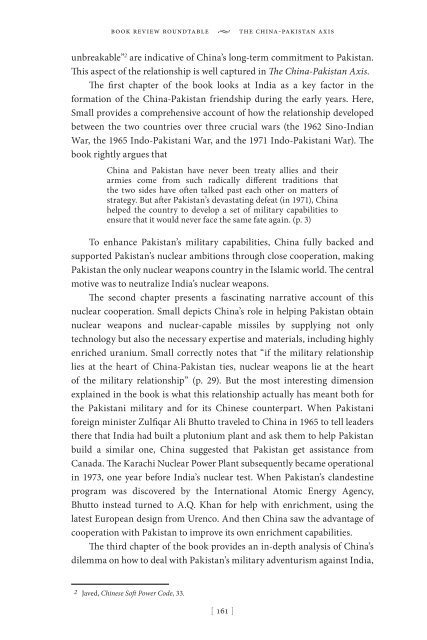You also want an ePaper? Increase the reach of your titles
YUMPU automatically turns print PDFs into web optimized ePapers that Google loves.
ook review roundtable • the china-pakistan axis<br />
unbreakable” 2 are indicative of China’s long-term commitment to Pakistan.<br />
This aspect of the relationship is well captured in The China-Pakistan Axis.<br />
The first chapter of the book looks at India as a key factor in the<br />
formation of the China-Pakistan friendship during the early years. Here,<br />
Small provides a comprehensive account of how the relationship developed<br />
between the two countries over three crucial wars (the 1962 Sino-Indian<br />
War, the 1965 Indo-Pakistani War, and the 1971 Indo-Pakistani War). The<br />
book rightly argues that<br />
China and Pakistan have never been treaty allies and their<br />
armies come from such radically different traditions that<br />
the two sides have often talked past each other on matters of<br />
strategy. But after Pakistan’s devastating defeat (in 1971), China<br />
helped the country to develop a set of military capabilities to<br />
ensure that it would never face the same fate again. (p. 3)<br />
To enhance Pakistan’s military capabilities, China fully backed and<br />
supported Pakistan’s nuclear ambitions through close cooperation, making<br />
Pakistan the only nuclear weapons country in the Islamic world. The central<br />
motive was to neutralize India’s nuclear weapons.<br />
The second chapter presents a fascinating narrative account of this<br />
nuclear cooperation. Small depicts China’s role in helping Pakistan obtain<br />
nuclear weapons and nuclear-capable missiles by supplying not only<br />
technology but also the necessary expertise and materials, including highly<br />
enriched uranium. Small correctly notes that “if the military relationship<br />
lies at the heart of China-Pakistan ties, nuclear weapons lie at the heart<br />
of the military relationship” (p. 29). But the most interesting dimension<br />
explained in the book is what this relationship actually has meant both for<br />
the Pakistani military and for its Chinese counterpart. When Pakistani<br />
foreign minister Zulfiqar Ali Bhutto traveled to China in 1965 to tell leaders<br />
there that India had built a plutonium plant and ask them to help Pakistan<br />
build a similar one, China suggested that Pakistan get assistance from<br />
Canada. The Karachi Nuclear Power Plant subsequently became operational<br />
in 1973, one year before India’s nuclear test. When Pakistan’s clandestine<br />
program was discovered by the International Atomic Energy Agency,<br />
Bhutto instead turned to A.Q. Khan for help with enrichment, using the<br />
latest European design from Urenco. And then China saw the advantage of<br />
cooperation with Pakistan to improve its own enrichment capabilities.<br />
The third chapter of the book provides an in-depth analysis of China’s<br />
dilemma on how to deal with Pakistan’s military adventurism against India,<br />
2 Javed, Chinese Soft Power Code, 33.<br />
[ 161 ]


